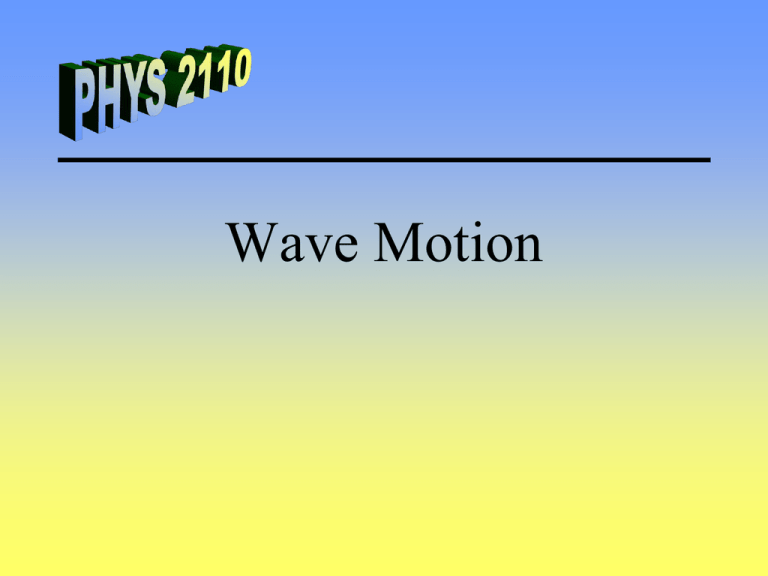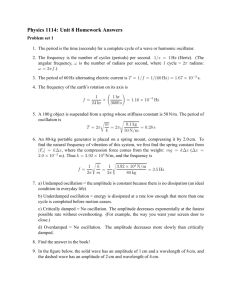Wave Motion
advertisement

Wave Motion Wave Types • Longitudinal – Motion parallel to energy transport • Transverse – Motion perpendicular to energy transport Properties of Waves • Wavelength – l, distance between crests • Frequency – f, # oscillations per second • Speed 1 f T – How quickly the disturbance moves A v l f l Equilibrium CDR Radio • What is the wavelength of CDR Radio? For FM stations the call numbers is the frequency of the station in megahertz f = 90.3×106 Hz Velocity for radio waves is the same as the speed of light. v = 3.0×108 m/s v l f Time Dependence • A moving function has both time and position dependence. y = f(x-v·t) (travel to the right) y = f(x+v·t) (travel to the left) 1, 0 x 0.5 • Ex. Haar Wavelet f ( x) T = 2s -2 m -1 m 1, T = 0s 0m 1m 0.5 x 1 2m Wave Number • Time dependent wave • Wave number k y A cos 2l x v t 2 l 2 • k is to l as w is to T w T • Another form y A cosk x w t Waves on a String • Wave velocity v T T = Tension = mass/length • Ex. What is the velocity of a wave pulse on a 1 mm diameter Copper wire w/ tension of 230 N? (rcu = 8.92 × 103 kg/m3) Sound Waves • Compression (High Pressure) • Rarefaction (Low Pressure) Comp. Equil. Rare. • Frequency Ranges – Infrasonic < 20 Hz – Audible 20 – 20k Hz – Ultrasonic > 20k Hz Speed of Sound • Air v B r v (331m / s) T 273K – Bulk modulus (B) - How easy it is to compress a volume of air. – At 20°C and sea level v = 343 m/s (air) • Solids v Y r – Young’s modulus (Y) - How easy it is to compress a solid. Sound Level • Intensity - Power transmitted per unit area. power P I 2 area 4r (Spherical Wave) • Intensity Level – Perceived intensity of sound. – Measured in decibels (dB) – 10 times the intensity is perceived as plus 10 dB – 2 times the intensity is perceived as plus 3 dB I 10 log I0 • Threshold of hearing, I0 = 1012 W/m2 Fireworks • 100 m away from an explosion the intensity level is 120 dB. What is the intensity level at 500 m? The Ear • Mechanical energy is converted into a neural signal in the cochea. – Nerve cells are triggered by the displacement of the basilar membrane. Superposition Principle • When 2 or more waves are present, the resulting wave is an algebraic sum of all the waves. yT y1 y2 • Interference Constructive - Waves in phase Destructive - Waves 180° out of phase A 2A -A A + -A -2A A 2A -A A + -A -2A Adding Waves At t = 0s, the crests of two waves are located at the origin. If the first wave has an amplitude of 5 cm and wavelength of 2 m and the second wave has an amplitude of 2 cm and a wavelength of 0.5 m, what does the resulting wave look like? Amplitude (cm) Superposition 10 5 0 -5 -10 0 1 2 Position (m) 3 4 Beats • Periodic variation in intensity with two waves close in frequency. y2 A cos2f 2t y1 A cos2f1t From Trig: cos a cos b 2 cos a 2 b cos a 2 b Therefore, y 2 A cos 2 f1 f 2 2 t cos 2 f1 f 2 2 t Modulation Oscillate Envelope Average freq. Beat Frequency • One speaker is transmitting a 10 Hz signal and a second is transmitting a 11 Hz signal. What beat frequency is experienced? f b f1 f 2 f b 1Hz Amplitude (cm) f b 10 Hz 11Hz Beats 15 10 5 0 -5 -10 -15 0 0.2 1 0.4 2 0.6 Position Position (m) (m) 30.8 14 Interference • Remember the Superposition Principle Constructive r2 r1 nl (n 0,1,2,) Destructive r2 r1 n 12 l (n 0,1,2,) r1 Source #1 #2 r2 Effect Earthquakes • S waves – Transverse – Shear • P waves – Longitudinal – Compression Northridge, CA 1994 Standing Waves • Two identical waves traveling in opposite directions. y1 A sin kx wt y2 A sin kx wt yT y1 y2 2 A sin kxcoswt • Antinodes - Max Amplitude nl x n 1, 3, 5 4 • Nodes - Zero Amplitude nl x n 0, 2, 4 4 Harmonic Series • Have a node at each end of the string. • Possible wavelengths 2L ln n • Frequency f v l L 1st harmonic n=1 fundamental 2nd harmonic n=2 1st overtone 3rd harmonic n=3 2nd overtone Waves on a String • General Form for normal modes – Nth harmonic 2L ln n n fn 2L F (n=1, 2, 3, …) Ex. A 4.0 g wire is stretched to its full length of 1.75 meters under a tension of 400 N. What frequency is heard as it vibrates in the wind? Double Open Ended Pipe • Air oscillates in and out of the pipe’s ends. 2L ln n nv fn 2L Fundamental 2nd Harmonic (n=1, 2, 3, …) 3rd Harmonic Air Displacement Single Open Ended Pipe • Air oscillates in and out of the pipe’s ends. 4L ln n nv fn 4L Fundamental 1st Overtone (n=1, 3, 5, …) 2nd Overtone Air Displacement Organ Pipe Ex. A pipe organ needs to play a low Bb (116.54 Hz). If a single open ended pipe is used, how long should the pipe be? What is the frequency of the 2nd overtone for this pipe? Doppler Effect • If a source is stationary wave are emitted radially outward. • Wavelength in direction of motion is compressed. • Therefore, frequency heard is f ' f v vO v vS (vS and vO considered positive when approaching each other) Doppler Effect • While standing at a corner, the siren of the police car goes from 530 Hz to 470 Hz as it passes by. How fast is the car traveling? Stationary Source Moving Source Shock Waves • Supersonic speeds – Mach Number vs Mach # v – Angle of shock wave v sin vs v – velocity of sound vs – velocity of the supersonic object v vs





